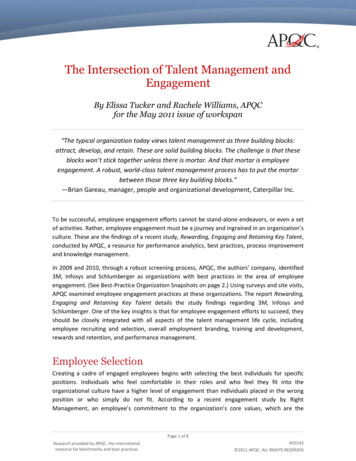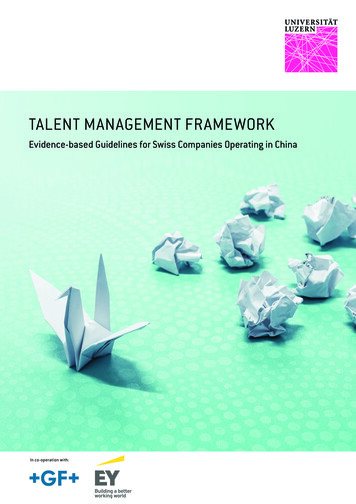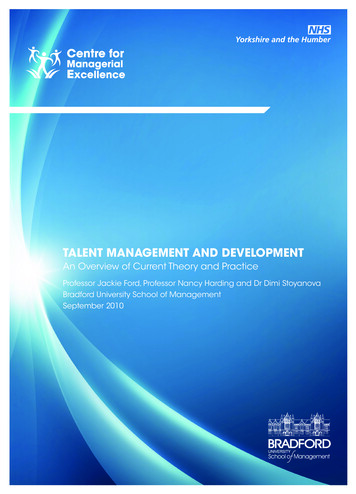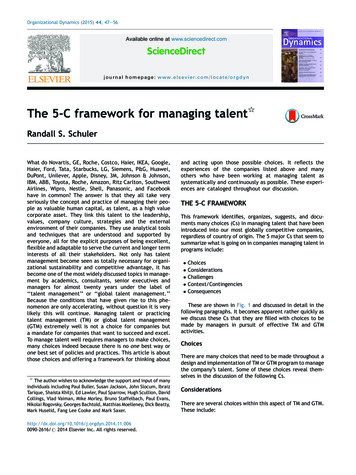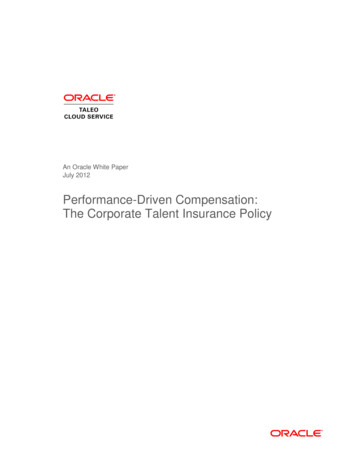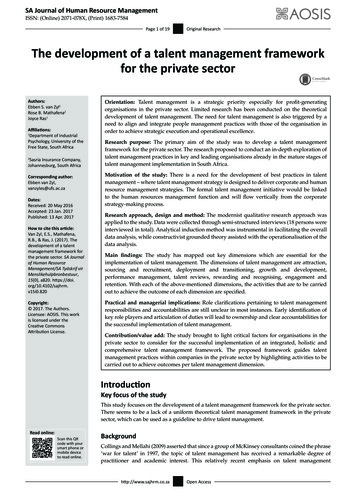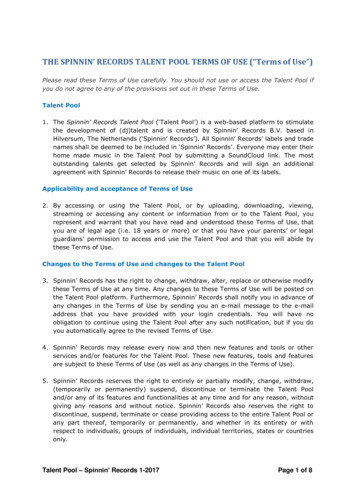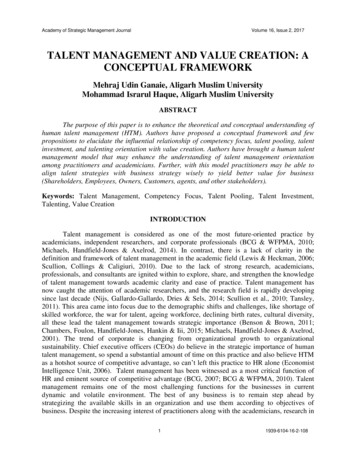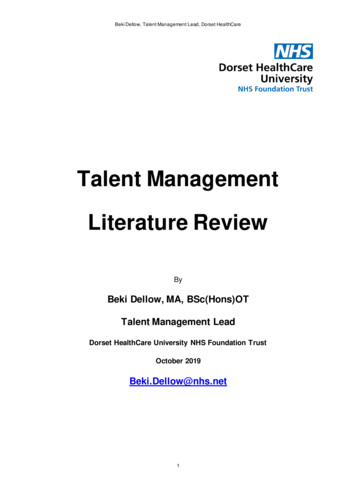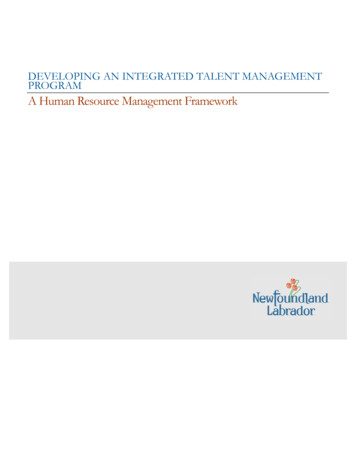
Transcription
1
Talent Acquisition andRetention: Making DataDriven DecisionsJohn Rutledge, SVP, Assurance2
Today’s ProgramCurrent ChallengesWhat Employees Really WantStaffing Industry DataBenefits Plan StrategiesImportance of Communication & Technology3
IntroductionUse of data Disconnect on New industry Impact of theExpandingApplies toemployeefor decisionsthe candidate both internal &perspectiveACAwantspooltempMinimizing risk. Maximizing health. 4
List of Research and Data SourcesSurveys and ResearchSHRMAdecco U.S.Willis Towers Watson –Emerging TrendsJellyvisionColonial LifeAMN/StaffcareGallup ResearchClutch Small Business HRSurveyPew ResearchBrandon Hall GroupRobert Half U.S.AberdeenMetLife – Employee BenefitTrends SurveyMonster.comThomsons Online BenefitsGlassdoor – EmployeeConfidence SurveyMercer ConsultingPalmer ForecastBenefit Focus2017 ALEX BenefitsCommunication SurveyBullhornWorldatWorkMRINetworkTelehealth Index: EmployerBenchmark SurveyLinkedInFractl – Survey of U.S.WorkersBusinessolverLIMRAPrice Waterhouse CooperCentre for GenerationalKineticsHarris PollOne Medical GroupEastbridgeMediums.comCommunication Partners,Inc.ADPPaychexAmerican Institute of CPAsRainmakerthinking.comPlanSourceDeLoitte Millennial SurveyHealthCare Cost InstituteDevnir ResearchMinimizing risk. Maximizing health. 5
List of Research and Data SourcesPublications and News SourcesStaffing Industry AnalystsLA TimesASA Staffing TODAYEmployee Benefits AdviserMoody’s AnalyticsWall Street JournalHealthLeaders MediaHR ExecutiveEmployee Benefit NewsThe New York TimesKaiser Health NewsCNBC.comReutersMarketWatchAmerican Staffing Association – “Turnover andTenure”Government and Nonprofit Data SourcesU.S. Department of LaborHealthCare Cost InstituteRoyal Swedish Academy of SciencesU.S. Bureau of Labor StatisticsEmployee Benefit Research InstituteCalifornia Office of Labor Standards EnforcementKaiser Family FoundationMinimizing risk. Maximizing health. 6
Industry Challenges7
Today’s Business Environment3.5%unemploymentrate Minimizing risk. Maximizing health. 59%receive multiple joboffers 3main decisionfactors8
Today’s Business Environment» Pressure to pay higher wages and offer more benefits» The vast majority of employers offer employee benefits» 90% of firms with an HR department offer benefits» 64% of those with some HR resources do offer benefits» Small businesses are impacted the most (WSJ)» This is one recruiting field for staffingMinimizing risk. Maximizing health. 9
Turnover» Turnover is an important stat for staffing» Lower turnover/longer tenure means improved margins and vice versa» ASA Research shows turnover decreased 2000 – 2013 and has been increasingsince – 420% in 2018; up from 386% in 2017» 27% of private-sector employees switched jobs in 2018» 25% of employees are looking for a new job at any given timeMinimizing risk. Maximizing health. 10
Competition From Other SectorsImproved Health BenefitsMore Benefit ChoicesFinancial PlanningFlexible SchedulesCollege Loan RepaymentMinimizing risk. Maximizing health. More Paid Time OffBenefits Communication11
What Employees Want12
Today’s Diverse & Changing Workforce» Four prominent and different generations:» Boomers» Gen X» Millennials» Gen Z» Each generation has its priorities and wants» Important to understand your workforce’s demographicsMinimizing risk. Maximizing health. 13
Baby Boomers: Our Data Says Workforce Total» Concerned about insufficientretirement funds & working longer» Most use technology but also liketelephonic support» Cost of healthcare and long-termcare is high on their listBaby Boomers27%Baby BoomersMinimizing risk. Maximizing health. Gen XMillennialsGen Z14
Generation X: Our Data Says Workforce Total» Personal finance is #1» Less money towards savings» Prefer communicating throughemail and telephone» Choice of medical, dental andsupplemental benefits are key21%Baby BoomersMinimizing risk. Maximizing health. Gen XMillennialsGen XGen Z15
Millennials: Our Data Says Workforce Total» Benefits are extremely important» Prefer online, texting, in-person ortelephone enrollment» Want inexpensive medical plans44%MillennialsBaby BoomersMinimizing risk. Maximizing health. Gen XMillennialsGen Z16
Generation Z: Our Data Says Workforce Total» Concerned about student loan debtGen Z8%» Remote work settings & non-traditional work arrangements» Social media, online portals, textingand infographics are preferred whenonboarding & communicating» Wellness & prevention plans keyBaby BoomersMinimizing risk. Maximizing health. Gen XMillennialsGen Z17
Non-Generational Issues» Only 18% of employers think a top challenge is creating aninclusive environment (and benefits) for all generations» 40% of U.S. households don’t have 400 for a deductible» Average out-of-pocket expense is now 4,700» #2 household expense in the U.S. is healthcare» 70% of temp candidates asked about benefits at job fairsMinimizing risk. Maximizing health. 18
Non-Generational Issues (cont.)» Benefits are preferred over higher salary w/no benefits» 89% of candidates consider health insurance a deal breaker» 80% of candidates choose additional benefits over a pay raise(Glassdoor Confidence Survey)YET» 77% of executives think pay is candidates’ top concern (Adecco USAMinimizing risk. Maximizing health. 19
Non-Generational Issues (cont.)» What do workers weigh most in deciding to stay or take a new job?Employees willing to pay 100% of the cost of many benefits if available (Mercer survey)Health Insurance61%More Pay54%Paid Vacation53%Flextime51%Retirement50%Non-Medical Benefits (Dental, 48%Paid Leave48%Profit Sharing40%0%Minimizing risk. Maximizing health. 10% 20% 30% 40% 50% 60% 70%20
The Appeal of Certain BenefitsMinimizing risk. Maximizing health. 21
Staffing Industry Data22
What Does the Data Say About Staffing?» ASA Staffing Today – ASA Workforce Monitor» Pay not number #1» Not as important as schedule» U.S. Government Accountability Report» 30%-40% of the workforce classify themselves as contingent» Only 11% of workers are willing to even consider a position withouthealth insuranceMinimizing risk. Maximizing health. 23
What Does the Data Say About Staffing? (cont.)» Demographics of temporary workers (U.S. Bureau of Labor Statistics)» Temporary workers are generally younger than other contingentworkers and those in traditional employment.» Temporary workers are less likely than traditional workers to haveattended college – although about half have at least 1 year ofcollege compared to 2/3 for other types of workers.» 46% of temporary workers would prefer a traditional jobMinimizing risk. Maximizing health. 24
Benefit Plan Strategies25
Things to Consider» Implementing Executive Medical Reimbursement plan» Conducting a demographic analysis» Thinking “benefits” instead of ACA» Looking at the new generation of low-cost, no-deductiblehealth plans or improving current MEC plan and renaming it» Providing the right optionsMinimizing risk. Maximizing health. 26
Things to Consider» Include benefits info in all job postings and social media» Studies prove workers place benefits above pay» Communicate and enroll during onboarding» 56% of workers say a company’s culture is valued more than salary» Onboarding is a critical time in the employment relationshipto communicate culture and key messages» Studies show onboarding impacts engagement and tenureMinimizing risk. Maximizing health. 27
Expand Your Candidate PoolReduce papercommunications;use technologyCommunicate& enroll duringonboardingMinimizing risk. Maximizing health. Use auto-textingto verify coverage& moreGive benefitsprominence &educate staff28
Improving MEC Plans at Little or No Cost» Convert current MEC plans into new low-cost, no-deductibleplans and drop terms like “MEC” and turn into a MEC “Plus”»»»»»More valued than deductible or indemnity plansLets employees know their cost of every covered serviceAdd coverage for doctor office visits with copaysAdd Rx with copays and perhaps embedded life insuranceAdd Telehealth benefits (offered by over 1/3 of all employers)» Understand the difference between health insurance andindemnity insurance» Use indemnity plans to supplement health insurance, not as the primaryproduct» Provide options – think packagesMinimizing risk. Maximizing health. 29
Messaging: Which Looks Better?ACA-Compliant PlanCoveragePreventive ServicesYour Health Insurance PlanMEC PlanBasic Health Plan100%100%Doctor Office Visits 25 copayGeneric Rx 15 copayDeductibleNo deductibleYour Weekly DeductionMinimizing risk. Maximizing health. 17.50 19.5030
Managing Profitability» Don’t pay more» Cost of enhanced MEC benefits within normal cost charged for most MECs» Studies show employees will pay for benefits that meet their needs» Consider where you invest compensation money» In downtimes, pay becomes more important» In good times, benefits rise in importance» 1 invested in benefits generates more profit compared to 1 in payroll Benefits do not carry payroll burden – average 14% more Some benefits can be done on a pre-tax basis which saves you over 7.5%» Make a small contribution toward a low-cost medical optionMinimizing risk. Maximizing health. 31
Communication & Technology32
3 Main Types of LearnersMinimizing risk. Maximizing health. 33
Communicate, Communicate, Communicate» Start at the recruiting process» Incorporate into onboarding» Use multiple communication media: print, internet, video,social media, mobile apps, infographics, telephonic/in-person» Consider outsourcing benefits administration» Consider “Total Reward Statements”Minimizing risk. Maximizing health. 34
Communicate, Communicate, Communicate» Enrollment communication» Get rid of paper and use technology» Keep messages simple» Make whatever enrollment method you use mandatory» Turn to internet-based options and self-service» Use free or inexpensive forms of communication 20avg. time choosingbenefitsMinimizing risk. Maximizing health. 35
Communicate, Communicate, Communicate» Better communication better employeeexperiences higher engagement» Outbound communications more effective fora decentralized workforce» Recommendations from Thaler’s research include: Mandate choices – opt out is better than opt in Make it simple – packaged options work Ensure frequency – ongoing auto-texting Provide decision support Offer easy access to benefits information via technologyMinimizing risk. Maximizing health. Richard Thaler, Nobel PrizeWinner in Economics, 201736
Switch to Default Enrollment With Opt-Out» Allowed by IRS in 2002 Revenue Ruling» Widely used for 401(k) and disability» Over 30% of employees refuse a free 401(k) if opting in45%employeesprefer» High persistency rate & improves satisfaction» Captures 100% offer of coverage for the ACA» Streamlines administration*Even though the DOL states ERISA preempts state withholding laws, still getemployee consent during onboardingMinimizing risk. Maximizing health. 55%Millennialsprefer37
Leveraging Technology“BenAdmin” (Benefits Administration)» Why?» 76% of candidates expect to be able to apply, receive feedback andget communications electronically» Make use of texting» Texting had a 99% open rate compared to email’s 8%» Texting had a 37% response rate compared to emails 2% (Staffing Tec)» Should not be subject to TCPA/CTIA opt-in requirements» Look for options that include call center supportMinimizing risk. Maximizing health. 38
Leveraging BenAdmin Technology *What can be automated?Applications, skills inventories, etc.Eligibility and eligibility changes *Offers of coverage*Enrollment/waivers*Payroll integration to automate deductions*Transmitting enrollment to insurance carriers*Employee benefits self-service*Benefits communications*ACA reporting data*Minimizing risk. Maximizing health. 39
Next Steps40
What’s Next?» Look for ways to beef up medical benefits without adding cost» Drop MEC and other ACA terms» Have your broker benchmark your plans» Make sure you have options that will appeal to your workforce» Have your broker do a demographic analysis» Enlist help from your broker in creating effective communications» Highlight benefits in job postings, website and social media» Review your onboarding process to maximize its impact» Use BenAdmin technology to communicate, enroll and managebenefitsMinimizing risk. Maximizing health. 41
Let’s Chat. Contact Us.Minimizing risk. Maximizing health. 42
List of Research and Data SourcesSurveys and ResearchSHRMAdecco U.S.Willis Towers Watson –Emerging TrendsJellyvisionColonial LifeAMN/StaffcareGallup ResearchClutch Small Business HRSurveyPew ResearchBrandon Hall GroupRobert Half U.S.AberdeenMetLife – Employee BenefitTrends SurveyMonster.comThomsons Online BenefitsGlassdoor – EmployeeConfidence SurveyMercer ConsultingPalmer ForecastBenefit Focus2017 ALEX BenefitsCommunication SurveyBullhornWorldatWorkMRINetworkTelehealth Index: EmployerBenchmark SurveyLinkedInFractl – Survey of U.S.WorkersBusinessolverLIMRAPrice Waterhouse CooperCentre for GenerationalKineticsHarris PollOne Medical GroupEastbridgeMediums.comCommunication Partners,Inc.ADPPaychexAmerican Institute of CPAsRainmakerthinking.comPlanSourceDeLoitte Millennial SurveyHealthCare Cost InstituteDevnir ResearchMinimizing risk. Maximizing health. 43
List of Research and Data SourcesPublications and News SourcesStaffing Industry AnalystsLA TimesASA Staffing TODAYEmployee Benefits AdviserMoody’s AnalyticsWall Street JournalHealthLeaders MediaHR ExecutiveEmployee Benefit NewsThe New York TimesKaiser Health NewsCNBC.comReutersMarketWatchAmerican Staffing Association – “Turnover andTenure”Government and Non-Profit Data SourcesU.S. Department of LaborHealthCare Cost InstituteRoyal Swedish Academy of SciencesU.S. Bureau of Labor StatisticsEmployee Benefit Research InstituteCalifornia Office of Labor Standards EnforcementKaiser Family FoundationMinimizing risk. Maximizing health. 44
Coming Next:ADA Compliance and Staffing WebsitesWednesday, October 30 at 2 PM ETStaffing World 2019 RecapThursday, November 14 at 2 PM ETReserve your seat: www.lunchwithhaley.comMinimizing risk. Maximizing health. 45
Minimizing risk. Maximizing health. 10 » Turnover is an important stat for staffing » Lower turnover/longer tenure means improved margins and vice versa » ASA Research shows turnover decreased 2000 -2013 and has been increasing since -420% in 2018; up from 386% in 2017 » 27% of private-sector employees switched jobs in 2018 » 25% of employees are looking for a new job at any given time

